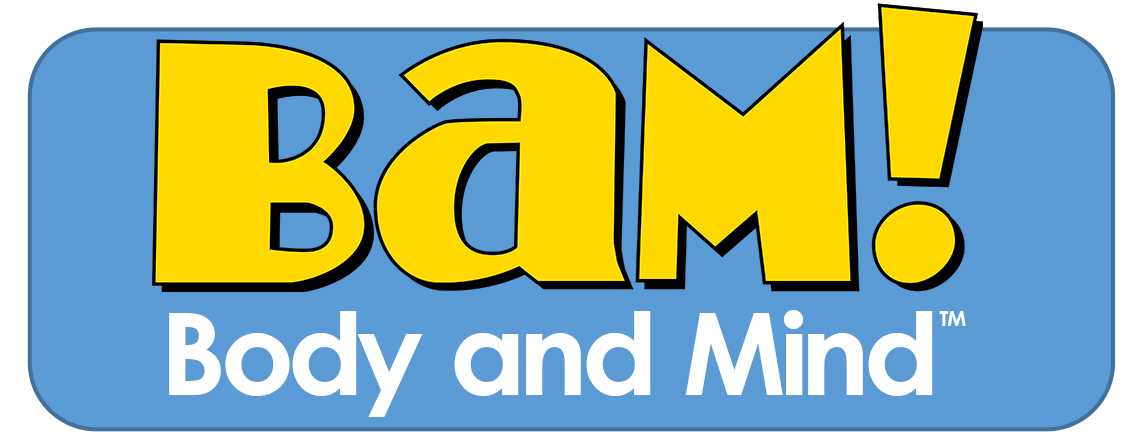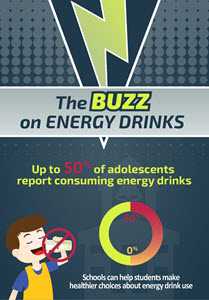The Buzz on Energy Drinks
What Is an Energy Drink?
- A beverage that typically contains large amounts of caffeine, added sugars, other additives, and legal stimulants such as guarana, taurine, and L-carnitine. These legal stimulants can increase alertness, attention, energy, as well as increase blood pressure, heart rate, and breathing.1-4
- These drinks are often used by students to provide an extra boost in energy. However, the stimulants in these drinks can have a harmful effect on the nervous system.5
The Potential Dangers of Energy Drinks
In 2007, 1,145 adolescents aged 12 to 17 went to the emergency room for an energy drink related emergency, in 2011 that number climbed to 1,499.6
Some of the dangers of energy drinks include1
- Dehydration (not enough water in your body)
- Heart complications (such as irregular heartbeat and heart failure)
- Anxiety (feeling nervous and jittery)
- Insomnia (unable to sleep)
How Much Caffeine Is Okay?
- The American Academy of Pediatrics recommends that Adolescents aged 12–18 years should not exceed 100 mg of caffeine a day 3, this is the amount of caffeine in a cup of coffee.9
What Can You Do?
- Teachers and other school staff can educate students about the danger of consuming too much caffeine, including energy drinks.
- Coaches can educate athletes about the difference between energy drinks and sports drinks and potential dangers of consuming highly caffeinated beverages.
- School nutrition staff can provide only healthy beverages such as fat-free/low-fat milk, water, and 100% juice if extra items (i.e., a la carte items) are sold in the cafeteria
- Parents, school staff, and community members can join the school or district wellness committee that sets the policies for health and wellness and establish or revise nutrition standards to address the sale and marketing of energy drinks in school settings.
- Everyone can model good behavior by not consuming energy drinks in front of kids.
Energy Drink Recommendations for Adolescents
- The American Academy of Pediatrics recommends that adolescents do not consume energy drinks, yet between 30–50% reported consuming energy drinks.1,3
- The National Federation of State High School Associations recommends that young athletes should not use energy drinks for hydration, and information about the potential risk should be widely distributed to young athletes.10
The Buzz on Energy Drinks Infographic
Fast Facts: Are Your Kids Getting These Drinks at School?
- While nationally only 1.2% of high schools sell energy drinks a la carte to students in the cafeteria,5 as many as 11.6% of secondary schools in some districts sell energy drinks in vending machines, school stores, and snack bars.7
- Nationwide, 75% of school districts do not have a policy in place regarding these types of beverages that contain high levels of caffeine for sale in vending machines, schools stores, or a la carte in the cafeteria.8
References
- Seifert SM, Schaechter JL, Hershorin ER, Lipshultz SE. Health effects of energy drinks on children, adolescents, and young adults. Pediatrics. 2011:peds. 2009–3592.
- Brown University Health Promotion. Energy Drinks. http://www.brown.edu/Student_Services/Health_Services/Health_Education/alcohol,_tobacco,_&_other_drugs/energy_drinks.php.
- Schneider MB, Benjamin HJ. Clinical Report–Sports Drinks and Energy Drinks for Children and Adolescents: Are They Appropriate? Pediatrics. 2011;127(6):1182–1189.
- Pomeranz JL, Munsell CR, Harris JL. Energy drinks: an emerging public health hazard for youth. Journal of public health policy. 2013; 34(2):254–271.
- Ishak WW, Ugochukwu C, Bagot K, Khalili D, Zaky C. Energy Drinks: Psychological Effects and Impact on Well-being and Quality of Life—A Literature Review. Innovations in Clincial Neuroscience. 2012;9(1):25–34.
- Center for Behavioral Health Statistics and Quality. The DAWN Report: Update on Emergency Department Visits Involving Energy Drinks: A Continuing Public Health Concern. Rockville, MD: Substance Abuse and Mental Health Services Administration; 2013.
- Demissie Z, Brener N, McManus T, Shanklin SL, Hawkins J, Kann L. School Health Profiles 2014: Characteristics of Health Programs Among Secondary Schools. In: Centers for Disease Control and Prevention, ed2014.
- Chriqui J, Resnick E, Schneider L, et al. School District Wellness Policies: Evaluating Progress and Potential for Improving Children’s Health Five Years after the Federal Mandate. School Years 2006-07 through 2010–11. Chicago, IL: Bridging the Gap Program, Health Policy Center, Instriture for Health Research and Policy, University of Illinois at Chicago; 2013.
- Heckman MA, Weil J, Gonzalez De Mejia E. Caffeine (1, 3, 7-trimethylxanthine) in Foods: A Comprehensive Review on Consumption, Functionality, Safety, and Regulatory Matters. Journal of Food Science. 2010;75(3):R77–87.
- National Federation of State High School Associations. Position Statement and Recommendations for the Use of Energy Drinks by Young Athletes; 2014.
- Page last reviewed: March 22, 2016
- Page last updated: March 22, 2016
- Content source:



 ShareCompartir
ShareCompartir
